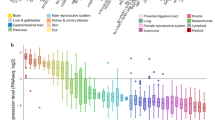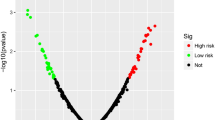Abstract
Background
The overall survival (OS) rate of adult patients suffering from acute myeloid leukaemia (AML) remains unsatisfactory at less than 40%. Current risk stratification systems fail to provide accurate guidelines for precise treatment. Novel biomarkers for predicting prognosis are urgently needed. Plexin B2 (PLXNB2), a functional receptor of angiogenin (ANG), has been found to be aberrantly expressed in multitudinous tumours. We detected overexpression of PLXNB2 mRNA in AML via transcriptome microarray analysis. This study aims to explore the potential role of PLXNB2 as a biomarker of prognosis and a prospective target of AML.
Methods
qRT‒PCR was conducted to verify the expression of PLXNB2 mRNA in bone marrow mononuclear cells from AML patients. Immunohistochemical and immunofluorescence staining were performed and confirmed increased expression of PLXNB2 protein in AML bone marrow tissues. Data on PLXNB2 expression, prognosis and clinical features were accessed from multiple bioinformatic databases, including The Cancer Genome Atlas (TCGA). Genes coexpressed and correlated with PLXNB2 were identified and analysed in the TCGA AML cohort. Metascape was applied for functional and pathway enrichment analysis of genes related to PLXNB2. Small molecular agents and traditional Chinese medicines potentially targeting genes related to PLXNB2 were screened via the Connectivity Map, TCMSP and HIT databases.
Results
PLXNB2 mRNA and protein levels are higher in AML samples than in normal controls. Overexpression of PLXNB2 is associated with worse OS in AML. Patients with high PLXNB2 expression might benefit more from haematopoietic stem cell transplantation (HSCT) (indicated by prolonged OS) than those with only chemotherapy treatment. Differentially expressed genes between the high and low PLXNB2 expression groups were overlapped with PLXNB2-coexpressed genes, and genes that overlapped were enriched in immune functions, endothelial cell regulation and cell interaction gene sets, indicating the potential function of PLXNB2 in AML. A total of 36 hub genes were identified from the differentially expressed genes, and MRC1, IL10, CD163 and CCL22 had significant prognostic value for AML. Analysis of the connectivity map and traditional agents revealed that honokiol, morphines, triptolide and paeoniflorin could be potential treatment regimens.
Conclusions
The overexpression of PLXNB2 is an adverse prognostic factor in adult AML patients and could be used as a potential biomarker. PLXNB2 might exert an oncogenic role by modulating immune functions, endothelial cell functions and cell interactions. AML patients with high PLXNB2 expression could benefit more from HSCT.
Highlights
-
PLXNB2 expression could be a potential biomarker of poor prognosis in AML.
-
HSCT could improve the prognosis of patients with high PLXNB2 expression.
-
PLXNB2 might regulate immunity, endothelial cells and cell interactions.





Similar content being viewed by others
Availability of data and materials
The datasets generated and/or analysed during the current study are available in the public databases mentioned in this manuscript.
Abbreviations
- ALL:
-
Acute lymphoblastic leukaemia
- AML:
-
Acute myeloid leukaemia
- ANG:
-
Angiogenin
- BMMCs:
-
Bone marrow mononuclear cells
- CCLE:
-
Cancer Cell Line Encyclopedia
- CIs:
-
Confidence intervals
- DAPI:
-
4',6-Diamidino-2-Phenylindole
- ELN:
-
European Leukaemia Net
- GEO:
-
Gene Expression Omnibus
- GO:
-
Gene Ontology
- HMA:
-
Hypomethylating agent
- HR:
-
Hazard ratio
- HSCs:
-
Haematopoietic stem cells
- HSCT:
-
Haematopoietic stem cell transplantation
- IF:
-
Immunofluorescence
- IHC:
-
Immunohistochemistry
- KEGG:
-
Kyoto Encyclopedia of Genes and Genomes
- OS:
-
Overall survival
- PLXNB2:
-
Plexin B2
- PPI:
-
Protein‒protein interaction
- qRT‑PCR:
-
Real‐time quantitative polymerase chain reaction
- TCGA:
-
The Cancer Genome Atlas
References
Bose P, Vachhani P, Cortes JE (2017) Treatment of relapsed/refractory acute myeloid leukemia. Curr Treat Options Oncol 18(3):17
Sami SA, Darwish NHE, Barile ANM, Mousa SA (2020) Current and future molecular targets for acute myeloid leukemia therapy. Curr Treat Options Oncol 21(1):3
Ivey A, Hills RK, Simpson MA, Jovanovic JV, Gilkes A, Grech A et al (2016) Assessment of minimal residual disease in standard-risk AML. N Engl J Med 374(5):422–433
Luger SM (2017) How can one optimize induction therapy in AML? Best Pract Res Clin Haematol 30(4):301–305
Lachowiez CA, Long N, Saultz JN, Gandhi A, Newell LF, Hayes-Lattin B et al (2022) Comparison and validation of the 2022 European LeukemiaNet guidelines in acute myeloid leukemia. Blood Adv. 7(9):1899–909
Short NJ, Tallman MS, Pollyea DA, Ravandi F, Kantarjian H (2021) Optimizing risk stratification in acute myeloid leukemia: dynamic models for a dynamic therapeutic landscape. J Clin Oncol 39(23):2535–2538
Shimony S, Stahl M, Stone RM (2023) Acute myeloid leukemia: 2023 update on diagnosis, risk-stratification, and management. Am J Hematol 98(3):502–526
Menghrajani K, Gomez-Arteaga A, Madero-Marroquin R, Zhang MJ, Bo-Subait K, Sanchez J et al (2022) Risk classification at diagnosis predicts post-HCT outcomes in intermediate-, adverse-risk, and KMT2A-rearranged AML. Blood Adv 6(3):828–847
Gao L, Zhang Y, Wang S, Kong P, Su Y, Hu J et al (2020) Effect of rhG-CSF combined with decitabine prophylaxis on relapse of patients with high-risk MRD-negative AML after HSCT: an open-label, multicenter Randomized Controlled Trial. J Clin Oncol 38(36):4249–4259
Dohner H, Estey E, Grimwade D, Amadori S, Appelbaum FR, Buchner T et al (2017) Diagnosis and management of AML in adults: 2017 ELN recommendations from an international expert panel. Blood 129(4):424–447
Dohner H, Wei AH, Appelbaum FR, Craddock C, DiNardo CD, Dombret H et al (2022) Diagnosis and management of AML in adults: 2022 recommendations from an international expert panel on behalf of the ELN. Blood 140(12):1345–1377
Totiger TM, Ghoshal A, Zabroski J, Sondhi A, Bucha S, Jahn J et al. Targeted Therapy Development in Acute Myeloid Leukemia. Biomedicines. 2023; 11(2).
Mrozek K, Kohlschmidt J, Blachly JS, Nicolet D, Carroll AJ, Archer KJ et al. Outcome prediction by the 2022 European LeukemiaNet genetic-risk classification for adults with acute myeloid leukemia: an Alliance study. Leukemia. 2023.
Zhang Y, Shen S, Li P, Fan Y, Zhang L, Li W et al (2019) PLEXIN-B2 promotes the osteogenic differentiation of human bone marrow mesenchymal stem cells via activation of the RhoA signaling pathway. Cell Signal 62:109343
Yang H, Yuan L, Ibaragi S, Li S, Shapiro R, Vanli N et al (2022) Angiogenin and plexin-B2 axis promotes glioblastoma progression by enhancing invasion, vascular association, proliferation and survival. Br J Cancer 127(3):422–435
Liu X, Chai Y, Liu G, Su W, Guo Q, Lv X et al (2021) Osteoclasts protect bone blood vessels against senescence through the angiogenin/plexin-B2 axis. Nat Commun 12(1):1832
Yu W, Goncalves KA, Li S, Kishikawa H, Sun G, Yang H et al (2017) Plexin-B2 mediates physiologic and pathologic functions of Angiogenin. Cell. 171(4):849–864
Xiang G, Cheng Y (2018) MiR-126-3p inhibits ovarian cancer proliferation and invasion via targeting PLXNB2. Reprod Biol 18(3):218–224
Brundu S, Napolitano V, Franzolin G, Lo Cascio E, Mastrantonio R, Sardo G et al (2023) Mutated axon guidance gene PLXNB2 sustains growth and invasiveness of stem cells isolated from cancers of unknown primary. EMBO Mol Med 15(3):e16104
Lv C, Sun L, Guo Z, Li H, Kong D, Xu B et al (2018) Circular RNA regulatory network reveals cell-cell crosstalk in acute myeloid leukemia extramedullary infiltration. J Transl Med 16(1):361
Chandrashekar DS, Karthikeyan SK, Korla PK, Patel H, Shovon AR, Athar M et al (2022) UALCAN: an update to the integrated cancer data analysis platform. Neoplasia 25:18–27
Nusinow DP, Szpyt J, Ghandi M, Rose CM, McDonald ER, Kalocsay M et al (2020) Quantitative proteomics of the cancer cell line encyclopedia. Cell. 180(2):387–402
Tang Z, Li C, Kang B, Gao G, Li C, Zhang Z (2017) GEPIA: a web server for cancer and normal gene expression profiling and interactive analyses. Nucleic Acids Res 45(W1):W98–W102
Lazzarotto D, Candoni A (2022) The Role of Wilms’ Tumor Gene (WT1) expression as a marker of minimal residual disease in acute myeloid leukemia. J Clin Med. 11:12
Heuser M, Freeman SD, Ossenkoppele GJ, Buccisano F, Hourigan CS, Ngai LL et al (2021) 2021 Update on MRD in acute myeloid leukemia: a consensus document from the European LeukemiaNet MRD Working Party. Blood 138(26):2753–2767
Lin L, Wang Y, Bian S, Sun L, Guo Z, Kong D et al (2021) A circular RNA derived from PLXNB2 as a valuable predictor of the prognosis of patients with acute myeloid leukaemia. J Transl Med 19(1):123
Van Battum E, Heitz-Marchaland C, Zagar Y, Fouquet S, Kuner R, Chedotal A (2021) Plexin-B2 controls the timing of differentiation and the motility of cerebellar granule neurons. Elife. 10:1
Yan H, Wu L, Shih C, Hou S, Shi J, Mao T et al (2017) Plexin B2 and Semaphorin 4C Guide T cell recruitment and function in the germinal center. Cell Rep 19(5):995–1007
Liang Y, Meng K, Qiu R (2021) Circular RNA Circ_0013958 functions as a tumor promoter in ovarian cancer by regulating miR-637/PLXNB2 Axis. Front Genet 12:644451
Acknowledgements
We appreciate Dr. Hang Yu for providing bioinformatic guidance and Dr. Jinming Li for equipment support.
Funding
This work was supported by grants from the “Major New Drug Development Project” of the Ministry of Science and Technology of China (2019ZX09201-002-003).
Author information
Authors and Affiliations
Contributions
ZG designed this study, wrote the original draft and was a major contributor in writing the manuscript. DG analysed the patient data and was also a major contributor in writing the manuscript. DK performed the histological examination of bone marrow. SB conducted qRT‒PCR. LZ collected clinical samples. QL, LL and JH were responsible for bioinformatic analysis. LS conceptualized and reviewed draft. YL conceptualized and reviewed draft. All authors read and approved the final manuscript.
Corresponding authors
Ethics declarations
Ethics approval and consent to participate
This study was conducted in conformity with the Declaration of Helsinki. This study was approved by the ethics committees of the First Affiliated Hospital of Harbin Medical University.
Consent for publication
Not applicable.
Competing interests
The authors declare that they have no conflicts of interest.
Additional information
Publisher's Note
Springer Nature remains neutral with regard to jurisdictional claims in published maps and institutional affiliations.
Supplementary Information
Below is the link to the electronic supplementary material.
Rights and permissions
Springer Nature or its licensor (e.g. a society or other partner) holds exclusive rights to this article under a publishing agreement with the author(s) or other rightsholder(s); author self-archiving of the accepted manuscript version of this article is solely governed by the terms of such publishing agreement and applicable law.
About this article
Cite this article
Guo, Z., Guo, D., Kong, D. et al. Expression analysis, clinical significance and potential function of PLXNB2 in acute myeloid leukaemia. Mol Biol Rep 50, 8445–8457 (2023). https://doi.org/10.1007/s11033-023-08721-w
Received:
Accepted:
Published:
Issue Date:
DOI: https://doi.org/10.1007/s11033-023-08721-w




